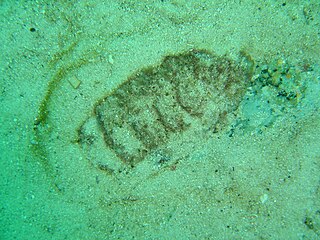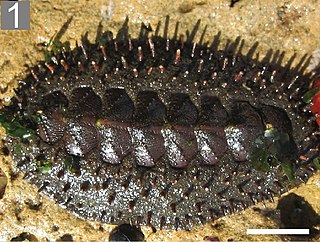
The hairy chiton is a species of chiton in the family Chaetopleuridae. It is a marine mollusc.
Chaetopleura pertusa, the orange hairy chiton, is a species of chitons in the family Chaetopleuridae. It is a marine mollusc. It is endemic to South Africa.

Dinoplax gigas, the giant chiton, is a species of chiton in the family Chaetopleuridae. It is a marine mollusc.

The cauliflower soft coral is a species of colonial soft coral in the family Nephtheidae.
Ischnochiton textilis, the textile chiton, is a medium-sized polyplacophoran mollusc in the family Ischnochitonidae, endemic to the coasts of South Africa and Namibia.
Ischnochiton oniscus, the dwarf chiton, is a small polyplacophoran mollusc in the family Ischnochitonidae, endemic to the coast of southern Africa.
Ischnochiton bergoti, the ribbed-scale chiton, is a small polyplacophoran mollusc in the family Ischnochitonidae, endemic to the west coast of southern Africa.
Chiton salihafui, the python chiton, is a medium-sized polyplacophoran mollusc in the family Chitonidae, found on the west coast of Africa.

Chiton politus, the tulip chiton, is a medium-sized polyplacophoran mollusc in the family Chitonidae, found on the coast of southern Africa.

Radsia nigrovirescens, the brooding chiton, is a small polyplacophoran mollusc in the family Chitonidae, found on the west coast of southern Africa.

Callochiton dentatus, the broad chiton, is a medium to large-sized polyplacophoran mollusc in the family Callochitonidae, found on the coast of southern Africa.

Acanthochitona garnoti, the spiny chiton, is a medium-sized polyplacophoran mollusc in the family Acanthochitonidae, found on the coast of southern Africa.

Onithochiton literatus, the black chiton, is a medium to large-sized polyplacophoran mollusc in the family Chitonidae, found on the east coast of Africa.

The marine ecoregions of the South African exclusive economic zone are a set of geographically delineated regions of similar ecological characteristics on a fairly broad scale, covering the exclusive economic zone along the South African coast.

Acanthopleura echinata is a Southeast Pacific species of edible chiton, a marine polyplacophoran mollusc in the family Chitonidae, the typical chitons.

The Marine biodiversity of South Africa is the variety of living organisms that live in the seas off the coast of South Africa. It includes genetic, species and ecosystems biodiversity in a range of habitats spread over a range of ecologically varied regions, influenced by the geomorphology of the seabed and circulation of major and local water masses, which distribute both living organisms and nutrients in complex and time-variable patterns.











